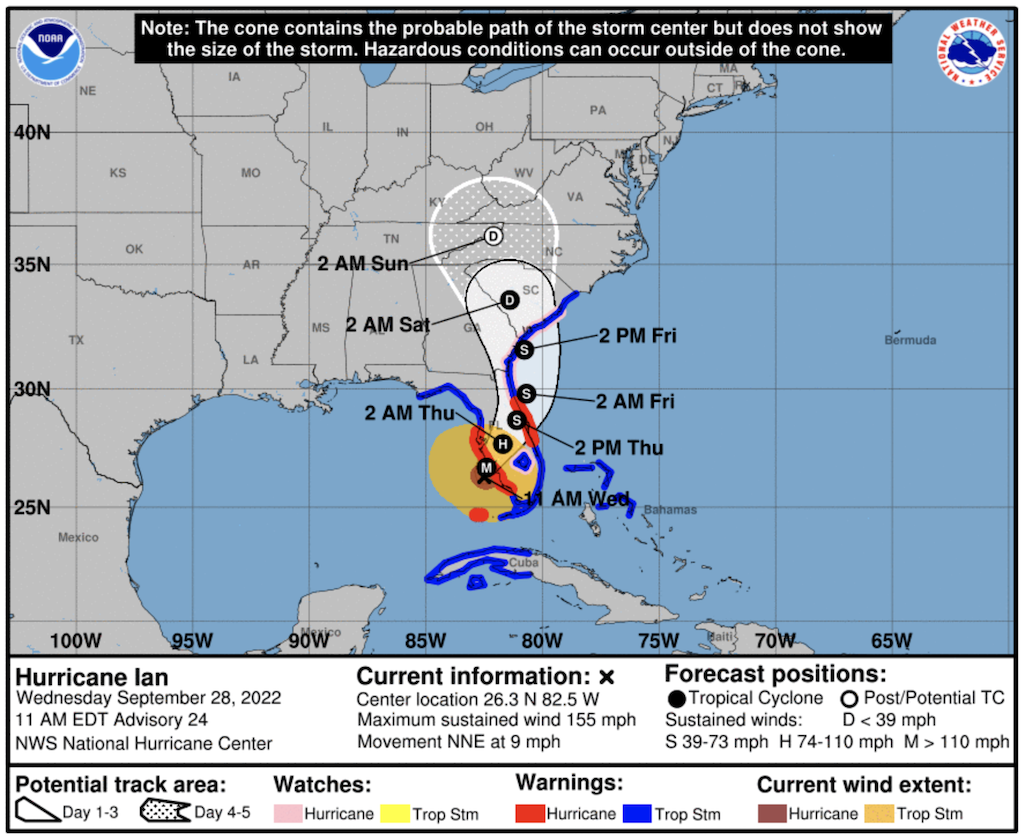
At least nine units of the National Park System have closed due to Hurricane Ian, which was expected to carry heavy rains up the Eastern Seaboard/NOAA
Editor's note: This updates with Gulf Islands National Seashore reopening, additional parks closing.
From the Florida Keys up into Georgia, Hurricane Ian was prompting units of the National Park System to shutter their operations before the storm hits. The powerful storm also was on track to carry heavy rains into Great Smoky Mountains National Park and along the Appalachian National Scenic Trail.
While the storm's slight swing to the east prevented Gulf Islands National Seashore from sustaining any damage and led to the reopening of its Florida operations, other units of the National Park System found themselves in the storm's path.
“Fortunately, Gulf Islands National Seashore did not sustain damages due to Hurricane Ian,” said Superintendent Darrell Echols. “The Fort Pickens area did have a substantial amount of sand on the roads and will require time to clean up. Our priority is to ensure the safest environment possible for park visitors and staff.”
Dry Tortugas National Park closed Monday to brace for the hurricane and remained closed Wednesday. Other parks that followed suit included:
- Big Cypress National Preserve
- Castillo de San Marcos National Monument
- DeSoto National Memorial
- Fort Pulaski National Monument
- Cumberland Island National Seashore
- Canaveral National Seashore
- Timucuan Ecological and Historic Preserve, including Fort Caroline National Memorial, Kingsley Plantation, Cedar Point, Theodore Roosevelt Area and Spanish Pond;
- Fort Frederica National Monument
- Everglades National Park
- Biscyane National Park
- Fort Sumter and Fort Moultrie National Historical Park and Charles Pinckney National Historic Site
While Cape Hatteras National Seashore did not announce closure plans, staff there did postpone the 150th anniversary celebration of Bodie Lighthouse planned for Saturday due to heavy rains in the forecast.
The National Hurricane Center on Wednesday morning said Ian "was expected to cause catastrophic storm surge, winds, and flooding in the Florida peninsula." Sustained winds with the hurricane were forecast to remain near 155 mph, with higher gusts possible. As the hurricane continues to move north, it is expected to degrade into a tropical storm with winds between 39 mph and 73 mph over Georgia and South Carolina on Friday before turning into a tropical depression with winds less than 39 mph over North Carolina and Tennessee and southern portions of Virginia, Kentucky, and West Virginia.
Heavy rains carried by the storm could drop 6-10 inches of water on parts of Georgia, South Carolina and coastal North Carolina, with 4-6 inches possible in western North Carolina, eastern Tennessee, and southern portions of Kentucky, Virginia, and West Virginia, the Hurricane Center forecast said.
"Widespread, life-threatening catastrophic flooding is expected across portions of Florida, southeastern Georgia, and coastal South Carolina," the center said. "Hurricane conditions are possible from northeastern Florida to portions of South Carolina on Thursday and Friday, and a hurricane watch has been issued for that area."
At the Appalachian Trail Conservancy, staff urged hikers along the southern end of the footpath to delay their hike.
"The ATC is closely monitoring the progress of Hurricane Ian as it approaches landfall in the southern United States. Current projections show a high likelihood of the storm impacting much of the southern Appalachian Trail corridor from Georgia to Virginia, which would include high winds and heavy rainfall," the organization said on its Facebook page. "Hikers are strongly encouraged to postpone any planned trips in this region until this storm passes."



Add comment